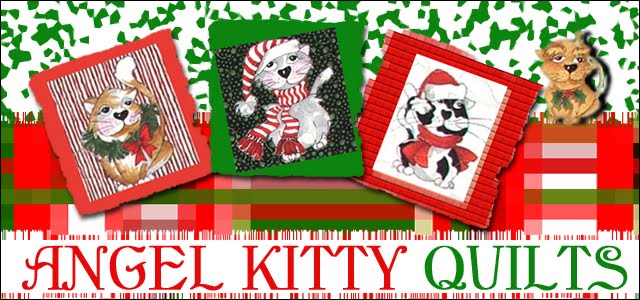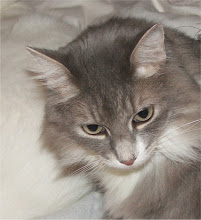Below is a collection of hand woven scarves which I've made in the last couple years. They are being donated to help raise green papers for our friend Fiona (da cat, not Monk's partner) get some much needed dental care.
The first item is made with hand dyed cotton yarn that has been dyed with cool-aid. It is almost four feet long and a tad less than 8 inches wide. It was desinged as a dresser scarf

The next scarf was woven by me. The warp yarn is a mixture of linen and silk, the weft yarn is man made (more likely woman made) from synthetic scrap that is dyed and spun in India by artisians.
Just for your gee-wiz, the warp is the length wise yarn in a weaving and the weft goes from side to side. The scarf has a crisp texture and would go well as a belt on a little black dress or as a scarf. It measures about 50 inches long and is 7 inches wide. The fringe is about six inches long.

These three scarves are all hand woven by me. The one on the left is soft wool yarn with just a tiny bit of gold tinsil woven in. The warp yarn is quite bulky (in a good way) and it's four feet 4 inches plus fringe. It's about 7 inches wide and is made for those cold winter winds.
The middle scarf is a light weight woven wool. It's one of my earlier projects so there may be a few boo-boo's in the weaving. It's a warm five feet five inches. This would be a great scarf for either a man or woman.
The last one, which I call black raspberry is a combination of two types of yarn. It is very soft and warm. It is five feet eight inches long, 8 inches wide with a fiveish inch fringe. It would go well with either a sweater or with a black outfit.
All scarves are made with high quality yarns.


The next two donation items were made in Bangaldesh. They are exquisite counted cross stich. The bookmark is 31/2 inches wide and 9 inches long. The saying beneath the child is "The lord is my Light. The second one is 7 inches by 15 (stiching size) on 11 1/2 by 19 inch peice of fabric. The second one would frame up beautifully or could be made into a pillow top.


The next is a crocheted shoulder bag made with what appears to be cotton yarn. It is unlined but could be used to hold yarn for a knitting or crochet project. It's about 8 inches wide and 12 inches long. The shoulder strap is about twelve inches.

The first item is made with hand dyed cotton yarn that has been dyed with cool-aid. It is almost four feet long and a tad less than 8 inches wide. It was desinged as a dresser scarf

The next scarf was woven by me. The warp yarn is a mixture of linen and silk, the weft yarn is man made (more likely woman made) from synthetic scrap that is dyed and spun in India by artisians.
Just for your gee-wiz, the warp is the length wise yarn in a weaving and the weft goes from side to side. The scarf has a crisp texture and would go well as a belt on a little black dress or as a scarf. It measures about 50 inches long and is 7 inches wide. The fringe is about six inches long.

These three scarves are all hand woven by me. The one on the left is soft wool yarn with just a tiny bit of gold tinsil woven in. The warp yarn is quite bulky (in a good way) and it's four feet 4 inches plus fringe. It's about 7 inches wide and is made for those cold winter winds.
The middle scarf is a light weight woven wool. It's one of my earlier projects so there may be a few boo-boo's in the weaving. It's a warm five feet five inches. This would be a great scarf for either a man or woman.
The last one, which I call black raspberry is a combination of two types of yarn. It is very soft and warm. It is five feet eight inches long, 8 inches wide with a fiveish inch fringe. It would go well with either a sweater or with a black outfit.
All scarves are made with high quality yarns.


The next two donation items were made in Bangaldesh. They are exquisite counted cross stich. The bookmark is 31/2 inches wide and 9 inches long. The saying beneath the child is "The lord is my Light. The second one is 7 inches by 15 (stiching size) on 11 1/2 by 19 inch peice of fabric. The second one would frame up beautifully or could be made into a pillow top.


The next is a crocheted shoulder bag made with what appears to be cotton yarn. It is unlined but could be used to hold yarn for a knitting or crochet project. It's about 8 inches wide and 12 inches long. The shoulder strap is about twelve inches.

.jpg)













